Did Queen Nitocris Build A Secret Underground Chamber To Commit Murder?
Ellen Lloyd - AncientPages.com - Queen Nitocris of ancient Egypt's Sixth Dynasty remains shrouded in mystery. Historians cannot agree whether Nitocris was a historical person or a mythical figure.
The fact that Herodotus, Eratosthenes, and Manetho mentioned her speaks in her favor as being a non-fiction person, but is it enough?
Manetho, an Egyptian high priest who lived in Sebennytos (in the Delta) during the Third Century B.C. and studied at the famous library of Alexandria, described Queen Nitocris as the bravest and most beautiful woman of her time.
He credited her with building the Third Pyramid and stated she reigned for twelve years. Eratosthenes of Cyrene (276 B.C. – 194 B.C.), a Greek mathematician, geographer, poet, and astronomer, wrote that her name meant Athena the Victorious, and she was supposed to reign for six years.
Herodotus (484 B.C. - 425/413 B.C.) is the Father of History and is famous for his work "Histories." He gives a colorful picture of Queen Nitocris' life. He writes, "After Menes came 330 kings whose names the priests recited from a papyrus roll. In all these generations were eighteen Ethiopian kings and one queen, a native of the country; the rest were all Egyptian men. The queen's name was the same as that of the Babylonian princess Nitocris..."
Herodotus wrote that Queen Nitocris committed murder and later suicide to avoid the consequences of her actions. Queen Nitocris, Herodotus wrote, ascended the throne after her brother, also her husband, was killed.
To avenge his death, she came up with a deceptive plan. Herodotus wrote, "she devised a cunning scheme by which she destroyed many Egyptians. She constructed a spacious underground chamber and, on the pretense of inaugurating it, threw a banquet, inviting all those she knew to have been responsible for the murder of her brother. Suddenly, as they were feasting, she let the river in upon them by means of a large, secret duct."
Later, she committed suicide by running into a burning room to escape vengeance. Our current knowledge of ancient history does not allow us to say whether there is any truth in the story of the queen's life, but Herodotus was convinced she did exist.
He further wrote that "after Menes came 330 kings whose names the priests recited from a papyrus scroll. In all these generations were eighteen Ethiopian kings and one queen, a native of the country; the rest were all Egyptian men. The queen's name was the same as that of the Babylonian princess Nitocris."
Historians have difficulties accepting Queen Nitocris as accurate because she is not mentioned in any native Egyptian inscription. She was allegedly the last female pharaoh of her dynasty and rose to power circa 2148-2144 BC, but there are no records of her reign.
For some time, it was believed that she was mentioned in the Turin King List under the Egyptian name of Nitiqreti. Later, scientists discovered this assumption was wrong.
Manetho stated she constructed the Third Pyramid, but we need to find out whether it was at Giza, and there are many pyramids in Egypt. It could have been any one of them. Archaeologists have not discovered her tomb, monuments dedicated to her, statuary, or texts. With solid evidence, it is therefore possible to prove Queen Nitocris was a historical person.
Modern historians disagree; some declare Nitocris a queen, and others say she is a mythical figure.
Written by Ellen Lloyd – AncientPages.com
Updated on Oct 1, 2023
Copyright © AncientPages.com All rights reserved. This material may not be published, broadcast, rewritten or redistributed in whole or part without the express written permission of AncientPages.com
Expand for referencesTyldesley - Chronicle of the Queens of Egypt
Newberry, Percy E. "Queen Nitocris of the Sixth Dynasty." The Journal of Egyptian Archaeology 29 (1943): 51-54. doi:10.2307/3855037.
More From Ancient Pages
-
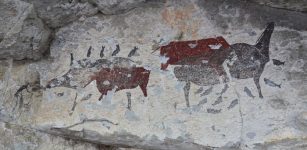 Unicorns In Southern Africa: The Fascinating Story Behind One-Horned Creatures In Rock Art
Featured Stories | Jun 24, 2023
Unicorns In Southern Africa: The Fascinating Story Behind One-Horned Creatures In Rock Art
Featured Stories | Jun 24, 2023 -
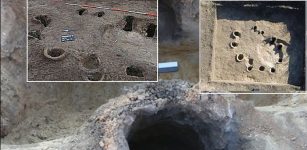 Celts In Poland: Iron Smelting Furnaces Used By Celts 2,400 Years Ago – Unearthed
Archaeology | Nov 30, 2019
Celts In Poland: Iron Smelting Furnaces Used By Celts 2,400 Years Ago – Unearthed
Archaeology | Nov 30, 2019 -
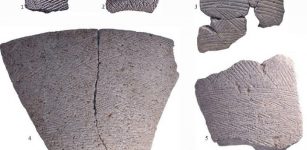 Mysterious Ancient ‘Triangle Code’ And Curious Markings Discovered On Vessels In Israel Reveal Something Interesting
Archaeology | Feb 11, 2019
Mysterious Ancient ‘Triangle Code’ And Curious Markings Discovered On Vessels In Israel Reveal Something Interesting
Archaeology | Feb 11, 2019 -
 Historical Enigma Of The Ancient Werewolf Ruler – What Powers Did He Possess?
Legends And Mysteries Of Europe | Jan 9, 2025
Historical Enigma Of The Ancient Werewolf Ruler – What Powers Did He Possess?
Legends And Mysteries Of Europe | Jan 9, 2025 -
 On This Day In History: Johannes Kepler ‘Father Of Modern Astronomy’ Was Born – On Dec 27, 1571
News | Dec 27, 2016
On This Day In History: Johannes Kepler ‘Father Of Modern Astronomy’ Was Born – On Dec 27, 1571
News | Dec 27, 2016 -
 12,000-Year-Old Ice Age Stone Tools Found – Earliest Dated Evidence For Human Activity in Scotland
Archaeology | Oct 10, 2015
12,000-Year-Old Ice Age Stone Tools Found – Earliest Dated Evidence For Human Activity in Scotland
Archaeology | Oct 10, 2015 -
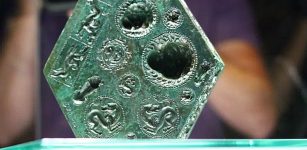 Unique 2,000-Year-Old Hexagonal-Shaped Bronze Matrix Of Sarmizegetusa Regia, Romania
Artifacts | Jan 7, 2016
Unique 2,000-Year-Old Hexagonal-Shaped Bronze Matrix Of Sarmizegetusa Regia, Romania
Artifacts | Jan 7, 2016 -
 Why We Celebrate Saint Lucy’s Day – The Bringer Of Light And Patron Of The Blind
Christmas Traditions | Dec 13, 2024
Why We Celebrate Saint Lucy’s Day – The Bringer Of Light And Patron Of The Blind
Christmas Traditions | Dec 13, 2024 -
 Ancient Hebrew Inscription Reveals Location Of Biblical Mount Sinai
Archaeology | Nov 21, 2019
Ancient Hebrew Inscription Reveals Location Of Biblical Mount Sinai
Archaeology | Nov 21, 2019 -
 Birds – Mysterious Avian Messengers That Symbolized Bridge Between Humans And Gods In World Beliefs
Myths & Legends | Aug 21, 2021
Birds – Mysterious Avian Messengers That Symbolized Bridge Between Humans And Gods In World Beliefs
Myths & Legends | Aug 21, 2021 -
 Stikini ‘Man-Owl’ – Sinister Vampiric Monster That Works In Disguise
Featured Stories | Jan 29, 2019
Stikini ‘Man-Owl’ – Sinister Vampiric Monster That Works In Disguise
Featured Stories | Jan 29, 2019 -
 Ancus Marcius: Semi-Legendary Fourth King Of Rome Obliged To Make War To Defend And Expend Territories
Featured Stories | Jul 12, 2019
Ancus Marcius: Semi-Legendary Fourth King Of Rome Obliged To Make War To Defend And Expend Territories
Featured Stories | Jul 12, 2019 -
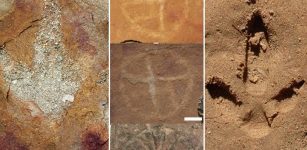 Intriguing Collection Of Petroglyphs And Dinosaur Footprints Found At The Serrote do Letreiro Site, Brazil
Archaeology | Mar 20, 2024
Intriguing Collection Of Petroglyphs And Dinosaur Footprints Found At The Serrote do Letreiro Site, Brazil
Archaeology | Mar 20, 2024 -
 Viking Children Were Buried With Extremely Sharp Knives – Afterlife Tools To Be Used In Valhalla?
Ancient History Facts | Nov 29, 2017
Viking Children Were Buried With Extremely Sharp Knives – Afterlife Tools To Be Used In Valhalla?
Ancient History Facts | Nov 29, 2017 -
 What Were The Most Important Inca Laws That All Citizens Had To Respect?
Ancient History Facts | Aug 16, 2017
What Were The Most Important Inca Laws That All Citizens Had To Respect?
Ancient History Facts | Aug 16, 2017 -
 Disappearance Of Neanderthals: Were Inbreeding And Demographic Shifts Responsible?
Archaeology | Nov 28, 2019
Disappearance Of Neanderthals: Were Inbreeding And Demographic Shifts Responsible?
Archaeology | Nov 28, 2019 -
 How Sæmundur The Wise Tricked The Devil Three Times
Featured Stories | Jun 8, 2020
How Sæmundur The Wise Tricked The Devil Three Times
Featured Stories | Jun 8, 2020 -
 A Researcher’s Life’s Work Uncovers First Ancient DNA From Swahili Civilization
Archaeology | Apr 2, 2023
A Researcher’s Life’s Work Uncovers First Ancient DNA From Swahili Civilization
Archaeology | Apr 2, 2023 -
 What Routes Did Homo Sapiens Take On His Way From Africa To Europe And Asia? Out Of Africa Path Examined
Archaeology | Dec 26, 2021
What Routes Did Homo Sapiens Take On His Way From Africa To Europe And Asia? Out Of Africa Path Examined
Archaeology | Dec 26, 2021 -
 Stone Age People Used Human Bones For Making Pendants
Archaeology | Jul 6, 2022
Stone Age People Used Human Bones For Making Pendants
Archaeology | Jul 6, 2022

